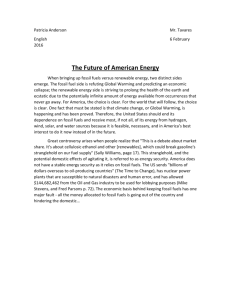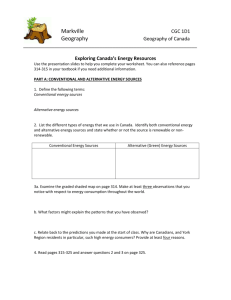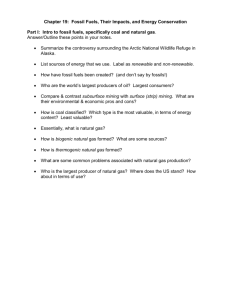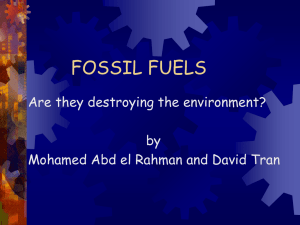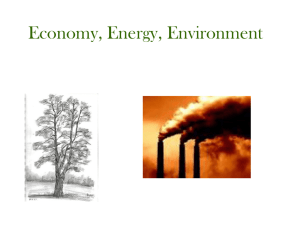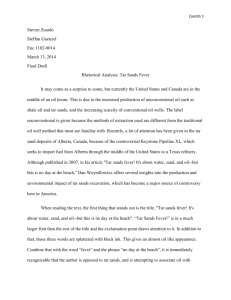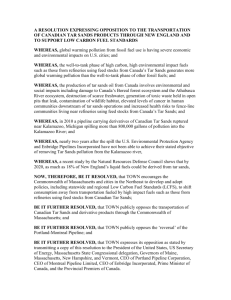Economy Growth DA
advertisement
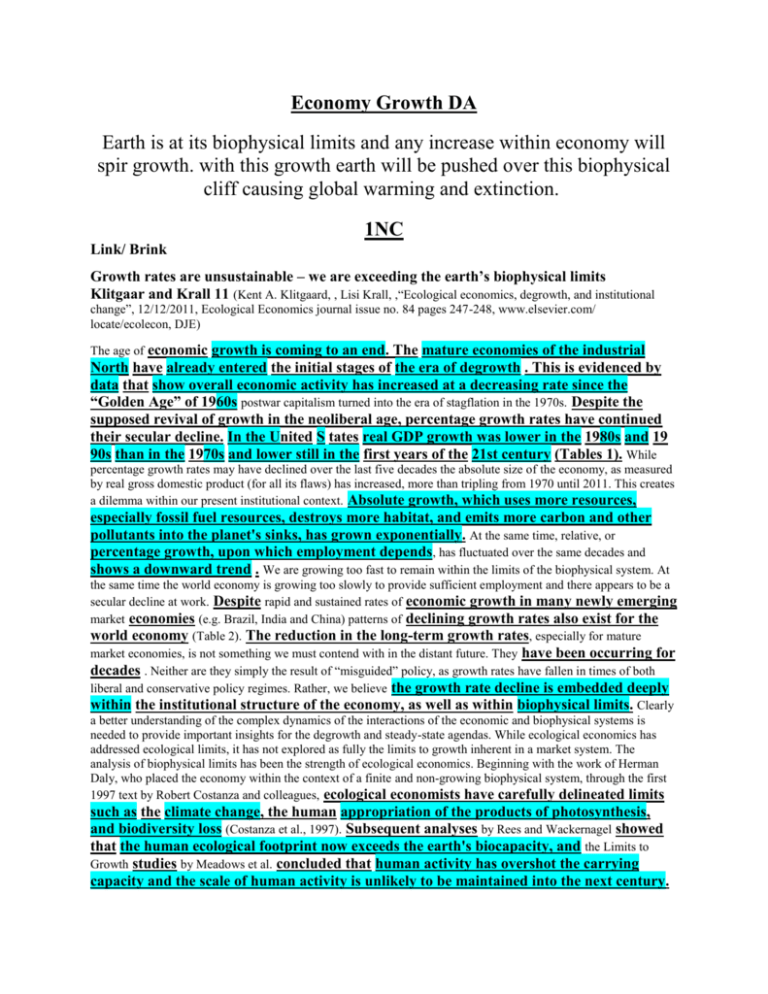
Economy Growth DA Earth is at its biophysical limits and any increase within economy will spir growth. with this growth earth will be pushed over this biophysical cliff causing global warming and extinction. 1NC Link/ Brink Growth rates are unsustainable – we are exceeding the earth’s biophysical limits Klitgaar and Krall 11 (Kent A. Klitgaard, , Lisi Krall, ,“Ecological economics, degrowth, and institutional change”, 12/12/2011, Ecological Economics journal issue no. 84 pages 247-248, www.elsevier.com/ locate/ecolecon, DJE) The age of economic growth is coming to an end. The mature economies of the industrial North have already entered the initial stages of the era of degrowth . This is evidenced by data that show overall economic activity has increased at a decreasing rate since the “Golden Age” of 1960s postwar capitalism turned into the era of stagflation in the 1970s. Despite the supposed revival of growth in the neoliberal age, percentage growth rates have continued their secular decline. In the United S tates real GDP growth was lower in the 1980s and 19 90s than in the 1970s and lower still in the first years of the 21st century (Tables 1). While percentage growth rates may have declined over the last five decades the absolute size of the economy, as measured by real gross domestic product (for all its flaws) has increased, more than tripling from 1970 until 2011. This creates a dilemma within our present institutional context. Absolute growth, which uses more resources, especially fossil fuel resources, destroys more habitat, and emits more carbon and other pollutants into the planet's sinks, has grown exponentially. At the same time, relative, or percentage growth, upon which employment depends, has fluctuated over the same decades and shows a downward trend . We are growing too fast to remain within the limits of the biophysical system. At the same time the world economy is growing too slowly to provide sufficient employment and there appears to be a secular decline at work. Despite rapid and sustained rates of economic growth in many newly emerging market economies (e.g. Brazil, India and China) patterns of declining growth rates also exist for the world economy (Table 2). The reduction in the long-term growth rates, especially for mature market economies, is not something we must contend with in the distant future. They have been occurring for decades . Neither are they simply the result of “misguided” policy, as growth rates have fallen in times of both liberal and conservative policy regimes. Rather, we believe the growth rate decline is embedded deeply within the institutional structure of the economy, as well as within biophysical limits. Clearly a better understanding of the complex dynamics of the interactions of the economic and biophysical systems is needed to provide important insights for the degrowth and steady-state agendas. While ecological economics has addressed ecological limits, it has not explored as fully the limits to growth inherent in a market system. The analysis of biophysical limits has been the strength of ecological economics. Beginning with the work of Herman Daly, who placed the economy within the context of a finite and non-growing biophysical system, through the first 1997 text by Robert Costanza and colleagues, ecological economists have carefully delineated limits such as the climate change, the human appropriation of the products of photosynthesis, and biodiversity loss (Costanza et al., 1997). Subsequent analyses by Rees and Wackernagel showed that the human ecological footprint now exceeds the earth's biocapacity, and the Limits to Growth studies by Meadows et al. concluded that human activity has overshot the carrying capacity and the scale of human activity is unlikely to be maintained into the next century. The work of many energy analysts (Campbell, 2005; Campbell and Laherrere, 1998; Deffeyes, 2001; Hall and Klitgaard, 2011; Hallock et al., 2004; Heinberg, 2005; Simmons, 2006) concludes that we are at or near the global peak of fossil hydrocarbons and future economic activity will be impacted strongly by more expensive and less available petroleum. The second set of limits is internal and is to be found in the dynamics of the accumulation process, involving the complex structural interaction of production, consumption, and distribution. The internal limits that gear the economy toward both cyclical variation and secular stagnation have not been considered systematically by ecological economists. When the economy reached these limits historically the result has been a series of periodic recessions and depressions. Renewed growth has been the answer, just as it is now. If the system reaches its own internal limits at the same time the world reaches its external biophysical limits we will have a profound challenge because we need a way to facilitate decent standards of living when economic growth can no longer be the vehicle to maintain incomes and assure social stability. In the last instance, a system in overshoot can neither growits way out of its inherent tendency toward stagnation, nor can it grow its way into sustainability. We believe it is unlikely that the present system of capitalism, dominated by multinational corporations, globalization, speculative finance, and dependence upon fossil fuels, can adjust to the era of degrowth and remain intact as is. In order to devise an economy that meets human needs as it approaches both sets of limits, ecological economics needs to understand more fully the structural and institutional dimensions of the internal and external limits, as well as the interaction between the two. This is our challenge, and it is a difficult one. Ecological economics can better understand the necessary institutional configuration of the non-growing economy only by an improved understanding of the dynamics of growth and capital accumulation, because it is here that the inherent tendencies to stagnate and the resolution to stagnation are found. EPA September 23, 2015 - climate change includes global warming Global warming refers to the recent and ongoing rise in global average temperature near Earth's surface. It is caused mostly by increasing concentrations of greenhouse gases in the atmosphere. Global warming is causing climate patterns to change. Unchecked global warming is catastrophic—action now is needed to prevent the collapse of civilization Hansen 12 — James Hansen, Director of the NASA Goddard Institute for Space Studies, Adjunct Professor in the Department of Earth and Environmental Sciences at Columbia University, holds a Ph.D. in Physics from the University of Iowa, 2012 (“Game Over for the Climate,” New York Times , May 12, Available Online at http://www.nytimes.com/2012/05/10/opinion/game-over-for-the-climate.html?_r=1&pagewanted=print , Accessed 7/18/14, Miriam) Global warming isn’t a prediction. It is happening. That is why I was so troubled to read a recent interview with President Obama in Rolling Stone in which he said that Canada would exploit the oil in its vast tar sands reserves “regardless of what we do.” If Canada proceeds, and we do nothing, it will be game over for the climate. Canada’s tar sands, deposits of sand saturated with bitumen, contain twice If we were to fully exploit this new oil source, and our conventional oil, gas and coal supplies, concentrations of carbon dioxide in the atmosphere eventually would reach levels higher than in the Pliocene era, more than 2.5 million years ago, when sea level was at least 50 feet higher than it is now. That level of heat-trapping gases would assure that the disintegration of the ice sheets would accelerate out of control. Sea levels would rise and destroy coastal cities. Global temperatures would become intolerable. Twenty to 50 percent of the planet’s species would be driven to extinction . Civilization would be at risk. That is the long-term outlook. But near-term, things will be bad enough. Over the next several decades, the Western United S tates and the semi-arid region from North Dakota to Texas will develop semi-permanent drought, with rain, when it does come, the amount of carbon dioxide emitted by global oil use in our entire history. continue to burn occurring in extreme events with heavy flooding. Economic losses would be incalculable. More and more of the Midwest would be a dust bowl. California’s Central Valley could no longer be irrigated. Food prices would rise to unprecedented levels. If this sounds apocalyptic, it is. This is why we need to reduce emissions dramatically. President Obama has the power not only to deny tar sands oil additional access to Gulf Coast refining, which Canada desires in part for export markets, but also to encourage economic incentives to leave tar sands and other dirty fuels in The global warming signal is now louder than the noise of random weather, as I predicted would We can say with high confidence that the recent heat waves in Texas and Russia, and the one in Europe in 2003, which killed tens of thousands, were not natural events — they were caused by human-induced climate change. We have known since the 1800s that carbon the ground. happen by now in the journal Science in 1981. Extremely hot summers have increased noticeably. dioxide traps heat in the atmosphere. The right amount keeps the climate conducive to human life. But add too much, as we are doing now, and temperatures will inevitably rise too high. This is not the result of natural variability, as some argue. The earth is currently in the part of its long-term orbit cycle where temperatures would normally be cooling. But they are rising — and it’s because we are forcing them higher with fossil fuel emissions. The concentration of carbon dioxide in the atmosphere has risen from 280 parts per million to 393 p.p.m. over the last 150 years. The tar sands contain enough carbon — 240 gigatons — to add 120 p.p.m. Tar shale, a close cousin of tar sands found mainly in the United States, contains at least an additional 300 gigatons of carbon. If we turn to these dirtiest of fuels, instead of finding ways to phase out our addiction to fossil fuels, there is no hope of keeping carbon concentrations below 500 p.p.m. — a level that would, as earth’s history shows, leave our children a climate system that is out of their control. We need to start reducing emissions significantly, not create new ways to increase them. We should impose a gradually rising carbon fee, collected from fossil fuel companies, then distribute 100 percent of the collections to all Americans on a per-capita basis every month. The government would not get a penny. This market-based approach would stimulate innovation, jobs and economic growth, avoid enlarging government or having it pick winners or losers. Most Americans, except the heaviest energy users, would get more back than they paid in increased prices. Not only that, the reduction in oil use resulting from the carbon price would be nearly six times as great as the oil supply from the proposed pipeline from Canada, rendering the pipeline superfluous, according to economic models driven by a slowly rising carbon price. But instead of placing a rising fee on carbon emissions to make fossil fuels pay their true costs, leveling the energy playing field, the world’s governments are forcing the public to subsidize fossil fuels with hundreds of billions of dollars per year. This encourages a frantic stampede to extract every fossil fuel through mountaintop removal, longwall mining, hydraulic fracturing, tar sands and tar shale extraction, and deep ocean and Arctic drilling. President Obama speaks of a “planet in peril,” but he does not provide the leadership needed to change the world’s course. Our leaders must speak candidly to the public — which yearns for open, honest discussion — explaining that our continued technological leadership and economic well-being demand a reasoned change of our energy The science of the situation is clear — it’s time for the politics to follow . This is a plan that can unify conservatives and liberals, environmentalists and business. Every major national science academy in the world has reported that global warming is real, caused mostly by humans, and requires urgent action. The cost of acting goes far higher the longer we wait — we can’t wait any longer to avoid the worst and be judged immoral by coming generations. course. History has shown that the American public can rise to the challenge, but leadership is essential.

